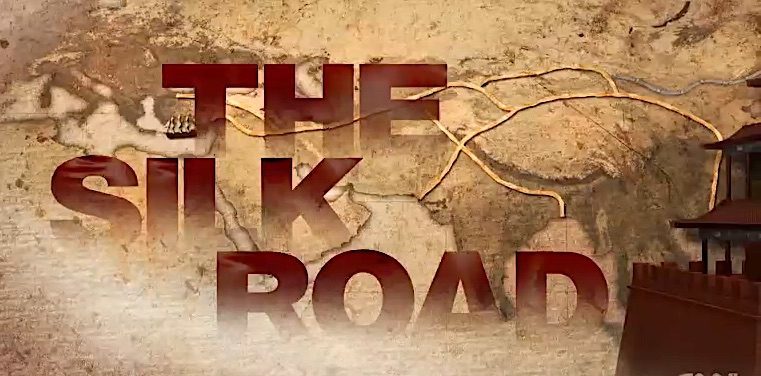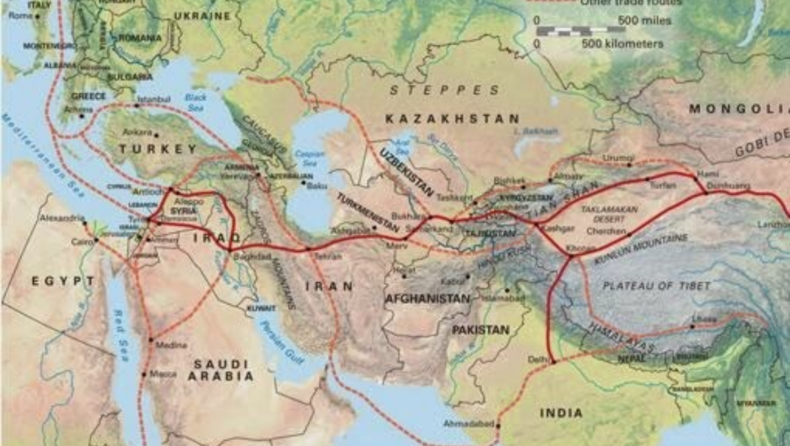Silk Road embodies the spirit of discovery and exchange. We want to encourage people to look for what unites them, instead of what divides them. – Laura Field
INTRODUCTION
The Silk Route has shaped human history in a way that no other trade route can. At first glance, we find nothing special about it, an ordinary trade route connecting Asia and Europe. But the fact is it is this trade route that has in one way or another contributed to and shaped human history since as back as the second century BCE. Earlier the word Silk Road was more prevalent in usage but it has fallen into disuse among some modern historians in favour of Silk Routes, which more accurately describes the intricate web of land and sea in East and Southeast Asia, the Indian subcontinent, Central Asia, the Middle East, East Africa and Europe. This route was actively used as long as the 14 century CE. It derives its name from the heavy trading of the silk fabric that took place along it. Silk considered to be a valuable fabric was originated in China and subsequently, the method of its production was for a long time kept a heavily guarded secret resulting in China having a monopoly on the Silk trade. Although silk was the most traded commodity along this route, the route also facilitated the trade of other fabrics, spices, grains, fruits and vegetables, animal hides, wood and metalwork, precious stones, and other items of value.

DESCRIPTION
In simple words, The Silk Route was a series of ancient trade networks that connected China and the Far East with countries in Europe and the Middle East. There were also various constructions along this route over time and eventually the route included a group of trading posts and markets that were used to help in the storage, transport, and exchange of goods. Travellers used camel or horse caravans and stayed in guest houses or inns typically spaced one day’s travel apart. Travellers along the Silk Route’s maritime routes could stop at ports for fresh drinking water and trade opportunities. Archaeologists and geographers pursuing research of ancient sites have been the Silk Route’s most modern travellers. The opening of the Silk Route brought many products that would have a big impact on the West. Many of these commodities had their roots in China and included gunpowder and paper. These became some of the most traded goods between China and its Western trading partners. Paper was especially important, as it eventually led to the invention of the printing press, which gave way to newspapers and books. The original Silk Route was established during the Han Dynasty by Zhang Quian, a Chinese official and diplomat. During a diplomatic mission, Quian was captured and detained for 13 years on his first expedition before escaping and pursuing other routes from China to Central Asia. The Silk Route was popular during the Tang Dynasty, from 618 to 907 A.D. Travellers could choose among several land and sea paths to reach their destination. The routes evolved along with territorial boundaries and changes in national leadership.
CHANGE AND COLLAPSE
The Silk Route was a means to exchange goods and cultures. It also served in the development of science, technology, literature, the arts, and other fields of study. The Silk Route also helped missions by Buddhist and European monks and was instrumental in spreading Buddhism, Christianity, Islam, Hinduism, and other religions throughout the regions served by the routes. The silk route connected one empire with another, it brought forward the most rudimentary structure of globalism to the world. In its roughly 1500 years of history, the silk route saw the fall and rise of various large empires as well as various major events such as the Black Death (Bubonic Plague). All these affected the silk route causing variations to it while some such as the Mongol Conquests strengthened it. The Silk Road trade played a significant role in opening political and economic relations between the east and the west. In addition to goods, the network facilitated an unprecedented exchange of ideas, religions (especially Buddhism), philosophies, and scientific discoveries, many of which were syncretised or reshaped by the societies that encountered them. Likewise, a wide variety of people utilized the routes, including migrants, refugees, missionaries, artisans, diplomats, and soldiers. Diseases such as the plague also spread along the Silk Road, possibly contributing to the Black Death. Despite having survived for more than a millennia the silk route collapsed in 1453 with the fall of the roman empire. The fall of Constantinople which brought about an end to the Roman Empire and led to the rise of the Ottoman Empire also brought about the end of the silk route. This led to European efforts to seek alternative routes to Eastern riches, thereby ushering in the Age of Discovery, European colonialism, and a more intensified process of globalization, which had arguably begun with the Silk Road.
PRESENT AND FUTURE
In recent times, there has been a push by China to reopen the Silk Route to improve cooperation among countries in Asia, Africa, and Europe. In 2013, China announced plans would revive the Silk Route, connecting it with more than 60 countries in Asia, Europe, Africa, and the Middle East. In 2013, China began to officially restore the historic Silk Route under president Xi Jinping with a $900 billion strategy called “One Belt, One Road” (OBOR). The project was a way to improve China’s interconnectivity with more than 60 other countries in Asia, Europe, and East Africa. Also known as the Belt and Road Initiative (BRI), it traverses numerous land and sea routes. The Silk Road Economic Belt is primarily land-based to connect China with Central Asia, Eastern Europe, and Western Europe, while the 21st Century Maritime Silk Road is sea-based, connecting China’s southern coast to the Mediterranean, Africa, South-East Asia, and Central Asia. China views the venture as an important way to improve its domestic growth. It also serves as a way to open up new trade markets for Chinese goods, giving the country the cheapest and easiest way to export materials and goods. Critics—including Malaysian Prime Minister Mahathir Mohamad—say China is using the BRI to lend to countries who may default as a way of getting economic or political concessions. China has passed several milestones related to the OBOR including the signing of hundreds of deals since 2016. In January 2017, a new rail service using the East Wind freight train was introduced from Beijing to London along the historic route, passing beneath the English Channel to reach London. The 16- to 18-day journey, travels nearly 7,500 miles and allows freight shippers an alternative to slow but relatively cheap water routes, and fast but relatively expensive air routes. Other key OBOR routes go from China to 14 major European cities. A part of the project called the China Pakistan Economic Corridor (CPEC) also passes through the territory of India and is currently a point of dispute between the two countries.
In June 2014, UNESCO designated the Chang’an-Tianshan corridor of the Silk Road as a World Heritage Site, while the Indian portion remains on the tentative site list.
CONCLUSION
We find that the silk road has had a substantial part in shaping human history and development through the ages and though it survived various major events it eventually gave in to the test of time and collapsed. Recently, China has done a great deal of effort and said that the ‘modern silk road’ has the potential to transform the face of global trade forever. It remains to be seen whether China’s actions are only for its domestic benefit (that too at the cost of others) or for global development and betterment. Global trade i.e., the movement of people, goods and ideas around the world is necessary for the advancement and betterment of all, something that can be proved using the recent situation caused due to the covid 19 pandemic. We must take lessons from the past, both good and bad and utilise them for the common good, history must play an important part in unfurling the mystery of the future.
Therefore, we find that the silk route is the path or the line that connects our past with our future with the potential to forever transform the world, for the better or the worse.












